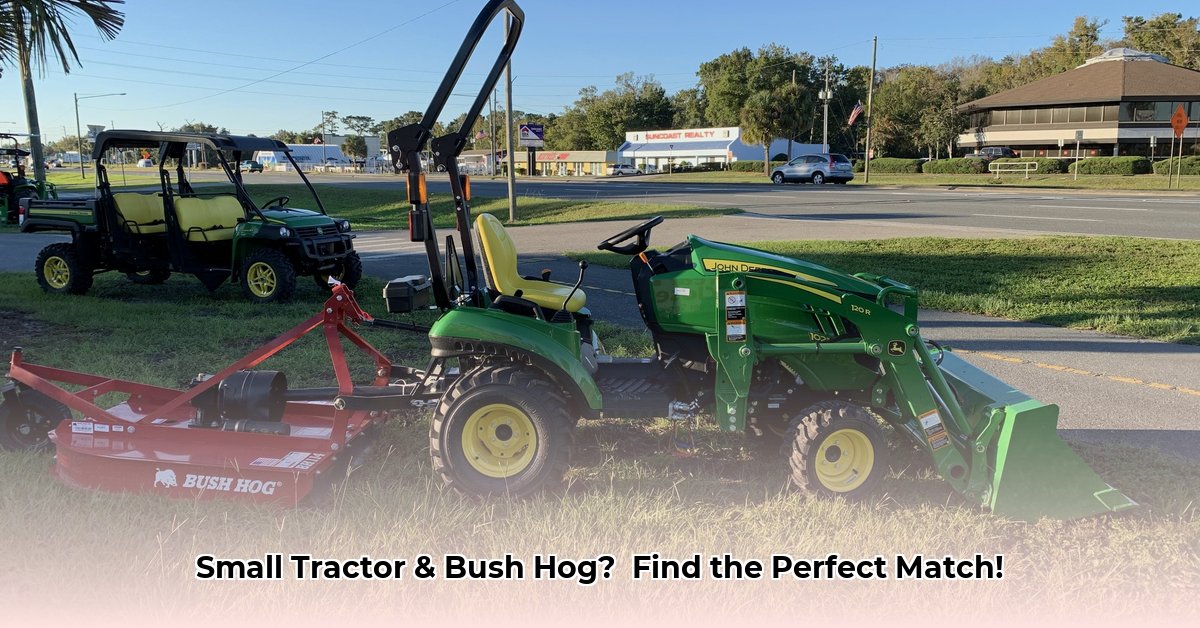
Choosing the right small tractor and bush hog is crucial for efficient and safe land management. This guide provides a step-by-step process to help you select the ideal equipment for your needs. For more information on tractor implements, check out this helpful resource: tractor implements.
Matching Your Small Tractor and Bush Hog: Power and Capacity
The key to successful land management lies in matching your tractor's capabilities to the bush hog's demands. Your tractor's power take-off (PTO) horsepower (the power delivered to the bush hog) and three-point hitch capacity (the ability to lift and support the implement) are critical factors.
A general rule suggests at least 15 PTO horsepower for a 4-foot-wide bush hog. Wider cutters require proportionally more horsepower. Always consult your tractor's manual for precise PTO horsepower and three-point hitch capacity ratings. Ignoring these specifications risks damaging your tractor's transmission and the bush hog itself. "Overloading the three-point hitch is a recipe for disaster," cautions Dr. Emily Carter, Agricultural Engineering Professor at Purdue University.
Brush Hog vs. Finish Mower: Choosing the Right Tool
Brush hogs and finish mowers serve different purposes. Brush hogs excel at tackling dense brush, overgrown fields, and rough terrain, ideal for initial land clearing. "A brush hog is the workhorse for tackling tough vegetation," explains John Miller, owner of Miller's Farm Equipment. Conversely, finish mowers offer precise cutting for a manicured look, perfect for lawns and pastures.
Step-by-Step Guide to Choosing Your Bush Hog
Assess Your Land: Determine vegetation density, acreage, and terrain complexity. This initial assessment directly impacts your bush hog selection.
Check Tractor Specifications: Consult your tractor's manual to determine its PTO horsepower and three-point hitch capacity. These specifications are non-negotiable.
Research Bush Hog Models: Match your tractor's capabilities with bush hog models, paying close attention to cutting width and weight. Will this impact your fuel efficiency? Larger cutting widths increase productivity but demand more power.
Consider Maintenance: Examine the ease of maintenance and parts availability for each model. Regular maintenance is crucial for the longevity of your equipment. Easy maintenance simplifies upkeep, while readily available parts reduce downtime.
Read Reviews: Review online forums and user feedback to gain insights into the performance and reliability of different models. User reviews offer a wealth of valuable insights that manufacturers' literature might miss.
Maintaining Your Equipment: A Key to Longevity and Safety
Regular maintenance ensures the longevity and safe operation of your equipment. This preventative maintenance dramatically extends the life of your equipment and makes for safer operation.
- Regular Inspections: Inspect for loose bolts, wear, and damage after each use.
- Blade Sharpening: Sharpen blades regularly to maintain cutting efficiency and reduce strain on the tractor and cutter.
- Lubrication: Regular lubrication of moving parts prevents wear and tear.
- Proper Storage: Store your equipment properly to protect it from the elements.
Safety First: Operating a Bush Hog Safely
Operating a bush hog involves inherent risks. Prioritize safety by:
- Wearing Protective Gear: Always wear safety glasses, hearing protection, sturdy work boots, and long pants.
- Clearing the Area: Remove obstacles before operation.
- Operating Cautiously: Avoid overworking the equipment.
- Maintaining Awareness: Be mindful of your surroundings. "Safety is paramount," stresses Sarah Chen, Safety Specialist at the National Farm Safety Association. "Never compromise on safety gear or procedures."
Bush Hog Size Guide: A Quick Reference Table
| Tractor PTO HP | Recommended Bush Hog Cutting Width (feet) | Notes |
|---|---|---|
| 15-20 | 4-5 | Ideal for smaller properties and lighter vegetation |
| 20-30 | 5-6 | Suitable for moderate vegetation density |
| 30+ | 6+ | For larger areas and heavier vegetation |
This table provides a guideline; actual needs may vary. Always consult your equipment manuals for specific operational and safety details. This is not a replacement for thorough training and reading the manufacturer's material.